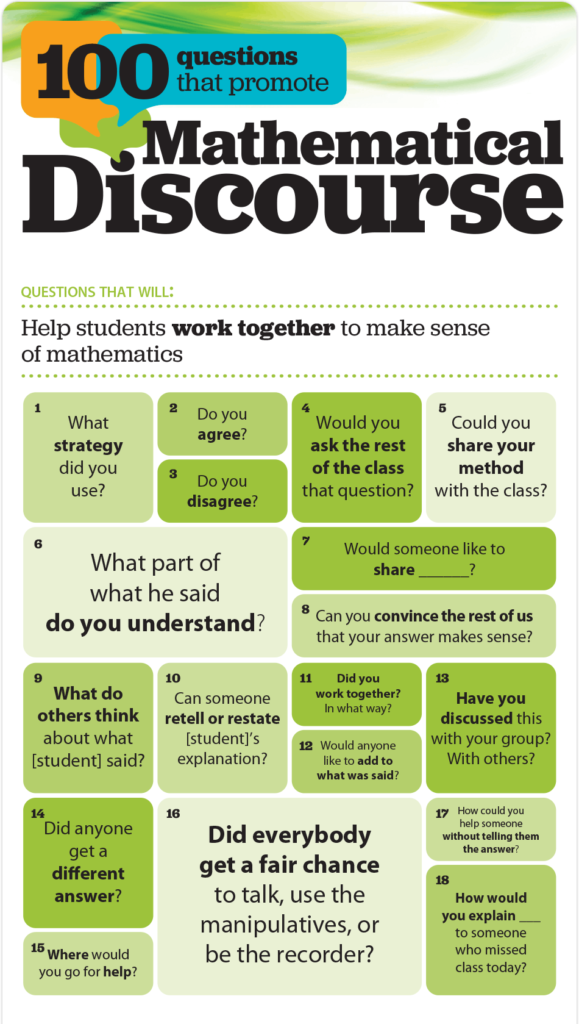Talking Math: 100 Questions That Help Promote Mathematical Discourse

Update 2022: For a recent article on how to talk about math, click here.
Think about the questions that you ask in your math classroom. Can they be answered with a simple “yes” or “no,” or do they open a door for students to really share their knowledge in a way that highlights their true understanding and uncovers their misunderstandings? Asking better questions can open new doors for students, helping to promote mathematical thinking and encouraging classroom discourse. Such questions help students:
- Work together to make sense of mathematics.
- Rely more on themselves to determine whether something is mathematically correct.
- Learn to reason mathematically.
- Evaluate their own processes and engage in productive peer interaction.
- Discover and seek help with problems in their comprehension.
- Learn to conjecture, invent and solve problems.
- Learn to connect mathematics, its ideas and its applications.
- Focus on the mathematical skills embedded within activities.
Below are 100 questions from mathematics expert Dr. Gladis Kersaint to help you address these core areas and promote mathematical thinking and discourse in the classroom. Want these questions visible in your classroom? Curriculum Associates has released an infographic that you can print and have at your desk or in your class for quick access! Here’s a preview:

For more, please download Dr. Kersaint’s new whitepaper: Orchestrating Mathematical Discourse to Enhance Student Learning.
Dr. Gladis Kersaint
Help students work together to make sense of mathematics
- What strategy did you use?
- Do you agree?
- Do you disagree?
- Would you ask the rest of the class that question?
- Could you share your method with the class?
- What part of what he said do you understand?
- Would someone like to share ___?
- Can you convince the rest of us that that makes sense?
- What do others think about what [student] said?
- Can someone retell or restate [student]’s explanation?
- Did you work together? In what way?
- Would anyone like to add to this?
- Have you discussed this with your group? With others?
- Did anyone get a different answer?
- Where would you go for help?
- Did everybody get a fair chance to talk, to use the manipulatives, or to be recorded?
- How could you help another student without telling the answer?
- How would you explain ___ to someone who missed class today?
Refer questions raised by students back to the class.
Help students rely more on themselves to determine whether something is mathematically correct
- Is this a reasonable answer?
- Does that make sense?
- Why do you think that? Why is that true?
- Can you draw a picture or make a model to show that?
- How did you reach that conclusion?
- Does anyone want to revise his or her answer?
- How were you sure your answer was right?
Help students learn to reason mathematically
- How did you begin to think about this problem?
- What is another way you could solve this problem?
- How could you prove that?
- Can you explain how your answer is different from or the same as [student]’s?
- Let’s see if we can break it down. What would the parts be?
- Can you explain this part more specifically?
- Does that always work?
- Is that true for all cases?
- How did you organize your information? Your thinking?
Help students evaluate their own processes and engage in productive peer interaction
- What do you need to do next?
- What have you accomplished?
- What are your strengths and weaknesses?
- Was your group participation appropriate and helpful?
Help students with problem comprehension
- What is this problem about? What can you tell me about it?
- Do you need to define or set limits for the problem?
- How would you interpret that?
- Would you please reword that in simpler terms?
- Is there something that can be eliminated or that is missing?
- Would you please explain that in your own words?
- What assumptions do you have to make?
- What do you know about this part?
- Which words were most important? Why?
Help students learn to conjecture, invent and solve problems
- What would happen if ___? What if not?
- Do you see a pattern?
- What are some possibilities here?
- Where could you find the information you need?
- How would you check your steps or your answer?
- What did not work?
- How is your solution method the same as or different from [student]’s?
- Other than retracing your steps, how can you determine if your answers are appropriate?
- What decision do you think he or she should make?
- How did you organize the information? Do you have a record?
- How could you solve this using (tables, trees, lists, diagrams, etc.)?
- What have you tried? What steps did you take?
- How would it look if you used these materials?
- How would you draw a diagram or make a sketch to solve the problem?
- Is there another possible answer? If so, explain.
- How would you research that?
- Is there anything you’ve overlooked?
- How did you think about the problem?
- What was your estimate or prediction?
- How confident are you in your answer?
- What else would you like to know?
- What do you think comes next?
- Is the solution reasonable, considering the context?
- Did you have a system? Explain it.
- Did you have a strategy? Explain it.
- Did you have a design? Explain it.
Help students learn to connect mathematics, its ideas and its application
- What is the relationship of this to that?
- Have we ever solved a problem like this before?
- What uses of mathematics did you find in the newspaper last night?
- What is the same?
- What is different?
- Did you use skills or build on concepts that were not necessarily mathematical?
- Which skills or concepts did you use?
- What ideas have we explored before that were useful in solving this problem?
- Is there a pattern?
- Where else would this strategy be useful?
- How does this relate to ___?
- Is there a general rule?
- Is there a real-life situation where this could be used?
- How would your method work with other problems?
- What other problem does this seem to lead to?
Help students persevere
- Have you tried making a guess?
- What else have you tried?
- Would another recording method work as well or better?
- Is there another way to (draw, explain, say) that?
- Give me another related problem. Is there an easier problem?
- How would you explain what you know right now?
Help students focus on the mathematics from activities
- What was one thing you learned (or two, or more)?
- Where would this problem fit on our mathematics chart?
- How many kinds of mathematics were used in this investigation?
- What were the mathematical ideas in this problem?
- What is the mathematically different about these two situations?
- What are the variables in this problem? What stays constant?
Facilitating student engagement in mathematical discourse begins with the decisions teachers make when they plan classroom instruction. In the next and final blog in this series, we will dive into the specific strategies that teachers can use to foster meaningful conversations about what students are thinking, doing and learning.
This blog is part of a three-post series on the importance of mathematical discourse from Curriculum Associates and Dr. Gladis Kersaint, the author of the recently published whitepaper Orchestrating Mathematical Discourse to Enhance Student Learning. Download your free copy here.
For more on mathematical discourse and Curriculum Associates, check out:
- Talking Math: How to Engage Students in Mathematical Discourse
- Talking Math: 6 Strategies for Getting Students to Engage in Mathematical Discourse
- Curriculum Associates: Leveraging For-profit Power With a Nonprofit Purpose
Dr. Gladis Kersaint is a Professor of Mathematics Education at the University of Connecticut.
Stay in-the-know with all things EdTech and innovations in learning by signing up to receive the weekly Smart Update. This post includes mentions of a Getting Smart partner. For a full list of partners, affiliate organizations and all other disclosures please see our Partner page.






Melissa Long
I love how you have the questions categorized by outcome goal. The infographic is one that I will be printing and using very often next year in my middle school classroom.
Joan Arumemi
It's an amazing application and approach in addressing math issues.Shall use them in my class .